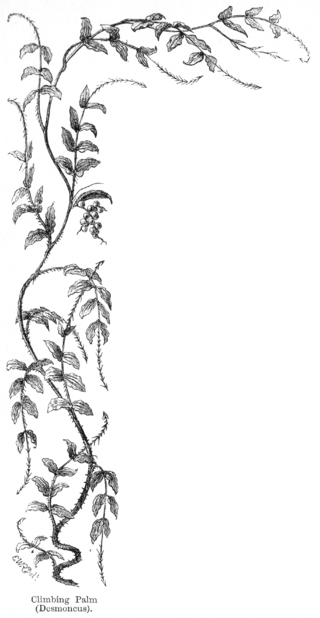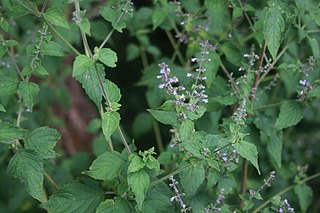
Mimosa is a genus of about 600 species of herbs and shrubs, in the mimosoid clade of the legume family Fabaceae. Species are native to the Americas, from North Dakota to northern Argentina, and to eastern Africa as well as the Indian subcontinent and Indochina. The generic name is derived from the Greek word μῖμος (mimos), an "actor" or "mime", and the feminine suffix -osa, "resembling", suggesting its 'sensitive leaves' which seem to 'mimic conscious life'.

Carl Friedrich Philipp von Martius was a German botanist and explorer. Between 1817 and 1820, he travelled 10,000 km through Brazil while collecting botanical specimens. His most important work was a comprehensive flora of Brazil, Flora Brasiliensis, which he initiated in 1840 and was completed posthumously in 1906.

Acacia, commonly known as wattles or acacias, is a genus of about 1,084 species of shrubs and trees in the subfamily Mimosoideae of the pea family Fabaceae. Initially, it comprised a group of plant species native to Africa, South America, and Australasia, but is now reserved for species mainly from Australia, with others from New Guinea, Southeast Asia, and the Indian Ocean. The genus name is Neo-Latin, borrowed from the Greek ἀκακία, a term used in antiquity to describe a preparation extracted from Vachellia nilotica, the original type species.

Monardella is a genus of approximately 40 species of annual and perennial plants native to western North America from British Columbia to northwestern Mexico. They are grown for their highly aromatic foliage, which in some species is used for herbal teas. The two-lipped, tubular flowers are formed in terminal clusters and are most usually red, pink, or purple.

Angelonia is a genus of about 30 species which occur from Mexico to Argentina and is classified in the Plantaginaceae. They are herbaceous plants occurring mainly in arid and semi-arid habitats. Most Angelonia species can be found in Northeastern Brazil in the seasonally-dry tropical forest namely Caatinga. The flowers of Angelonia are highly specialized for pollination because they have hairs in the inner corolla, which produces oils collected by oil bee pollinators, especially of the genus Centris.

Wittmackia is a genus of flowering plants in the family Bromeliaceae.

Desmoncus is a genus of mostly climbing, spiny palms native to the Neotropics. The genus extends from Mexico in the north to Brazil and Bolivia in the south, with two species present in the southeastern Caribbean.

Hebanthe is a genus of flowering plant in the family Amaranthaceae, native to Mexico to southern tropical America. The genus was first described by Carl von Martius.

Lepechinia is a genus of plants in the mint family, Lamiaceae. It includes several species of plants known commonly as pitchersages. Plants of this genus can be found in Central and South America, Mexico, California, Hispaniola, and Hawaii, although the species in Hawaii is probably a human introduction. Many of them bear attractive pitcher-shaped flowers, often in shades of purple. The genus was named for the Russian botanist Ivan Ivanovich Lepechin. In 2011, the two monotypic genera Chaunostoma and Neoeplingia were shown to be part of Lepechinia.
Remijia is a genus of flowering plants in the family Rubiaceae. Within the family, it is a member of the subfamily Cinchonoideae and the tribe Cinchoneae.
Ludwig Benjamin (1825–1848) was a German botanist who contributed to Carl Friedrich Philipp von Martius' Flora Brasiliensis. The genus Benjaminia is named in his honour.

Streptochaeta is a genus of plants in the grass family. It is the only genus in the tribe Streptochaeteae of the family Poaceae.

Luehea is a genus of trees in the family Malvaceae.

Cantinoa is a genus of flowering plants in the family Lamiaceae. It is native primarily to New World, with some species introduced in the old world.
Solonia is a monotypic genus of flowering plants belonging to the family Primulaceae, with just contains one species, Solonia reflexaUrb.
Sebastiano-schaueria is a monotypic genus of flowering plants belonging to the family Acanthaceae. The only known species is Sebastiano-schaueria oblongata.
Martianthus is a genus of flowering plants belonging to the family Lamiaceae.

Davilla is a genus of flowering plants belonging to the family Dilleniaceae. It has around 30 neotropical, species and is one of the most diverse genera of lianas, vines, erect or scandent shrubs.

Mollia is a genus of flowering plants belonging to the family Malvaceae. It is within the Grewioideae subfamily, and the Grewieae tribe.
Bionia is a small genus of flowering plants in the family Fabaceae, subfamily Faboideae, native to central and eastern Brazil. It was resurrected from Camptosema.














